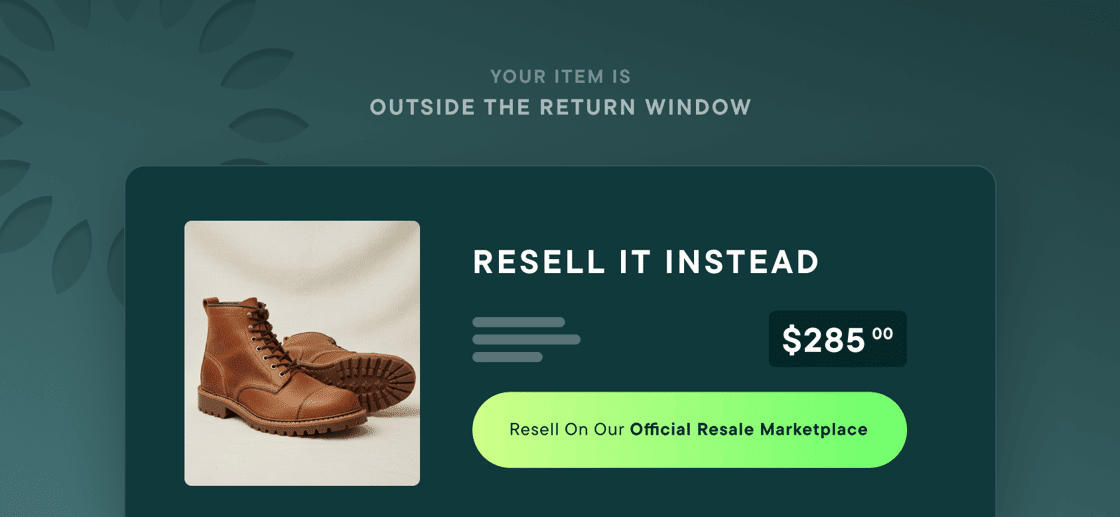.png)
Picture this: A shopper bought a jacket for a trip. They missed the 30-day return window by a week. When they go to send it back, the return portal says no.
In that moment, a few things happen:
- They’re disappointed (maybe annoyed enough not to come back).
- The jacket probably ends up in a closet — or gets listed on Poshmark.
- The brand loses not just the item’s value but a future customer.
Multiply that by scale: Loop estimates 13% of all return attempts fall outside policy.
That’s millions of dollars in stranded inventory every year across ecommerce, and thousands of frustrated shoppers who learn to buy, and resell somewhere else.
The Bigger Problem Behind Policy-Blocked Returns
Returns have always been treated as a cost center: reverse logistics, refunds, support tickets.
But what often goes unseen is the loyalty cost.
- A blocked return is a churn moment. NPS drops. Future LTV evaporates.
- Brands eat inventory loss or push customers to third-party marketplaces like Poshmark and Depop, where control, and revenue, disappear.
- Support teams burn time explaining policy, often turning a frustrated shopper into a lost one.
This is a silent leak in ecommerce. And until now, there hasn’t been a clean, on-brand way to fix it.
How the Treet + Loop Integration Works
The new Treet + Loop integration turns those dead ends into something valuable.
- A customer starts a return in Loop.
- Loop checks eligibility.
- If the item’s outside policy (final sale, worn, late), instead of “Sorry, can’t return,” the shopper sees: Resell on [Your Brand’s] Marketplace.
- They can list the item instantly, with product info pre-filled.
- When it sells, they choose cash or 100%+ store credit.
For the customer, it’s simple and on-brand. For the brand, it:
- Unlock new revenue on items previously sold on third-party marketplaces.
- Retains customers by giving them value back and reason to return.
- Reduces support pain with a positive alternative.
And the technical lift? Minimal. It’s a toggle-ready integration right inside the Loop marketplace.

Why It’s More Than a Nice-to-Have
This isn’t just a smoother return flow, it’s a strategic shift.
- New revenue: Brands can finally monetize a chunk of inventory (13%) that used to walk out the door.
- Incremental purchases: When shoppers take store credit, they typically spend more than the credit value.
- Brand control: Instead of training customers to resell on third parties, you keep them in your own ecosystem.
- Support efficiency: Fewer angry tickets, faster resolution, happier customers.
Early beta brands are reporting exactly that:
- Customer satisfaction rising in post-return surveys.
- New resale revenue from items previously written off.
- Lower support friction when policy-blocked returns have a clear next step.
FAQ
What happens when an item sells?
The customer gets cash or store credit. You capture margin on the resale and often a new full-price purchase when they spend beyond their credit.
Is it hard to set up?
No. It’s a toggle-on integration in the Loop marketplace. No custom engineering required.
The Takeaway
Every return portal interaction is a moment of truth. For years, 13% of those moments ended in frustration and lost lifetime value.
With Treet + Loop, that 13% becomes:
- Revenue recovered instead of written off.
- Customers kept instead of lost to third-party marketplaces.
- A brand experience that feels modern, seamless, and customer-first.
And it's one of the easiest integrations you'll every turn on. Don't just take our word for it.
I think this might have been the easiest integration I have setup in my whole career haha Thanks for making it so easy!
Pat Osiadacz, Head of Project Delivery, Represent
It’s time to stop letting missed returns walk out the door.
👉 Learn how to enable the Treet + Loop integration







